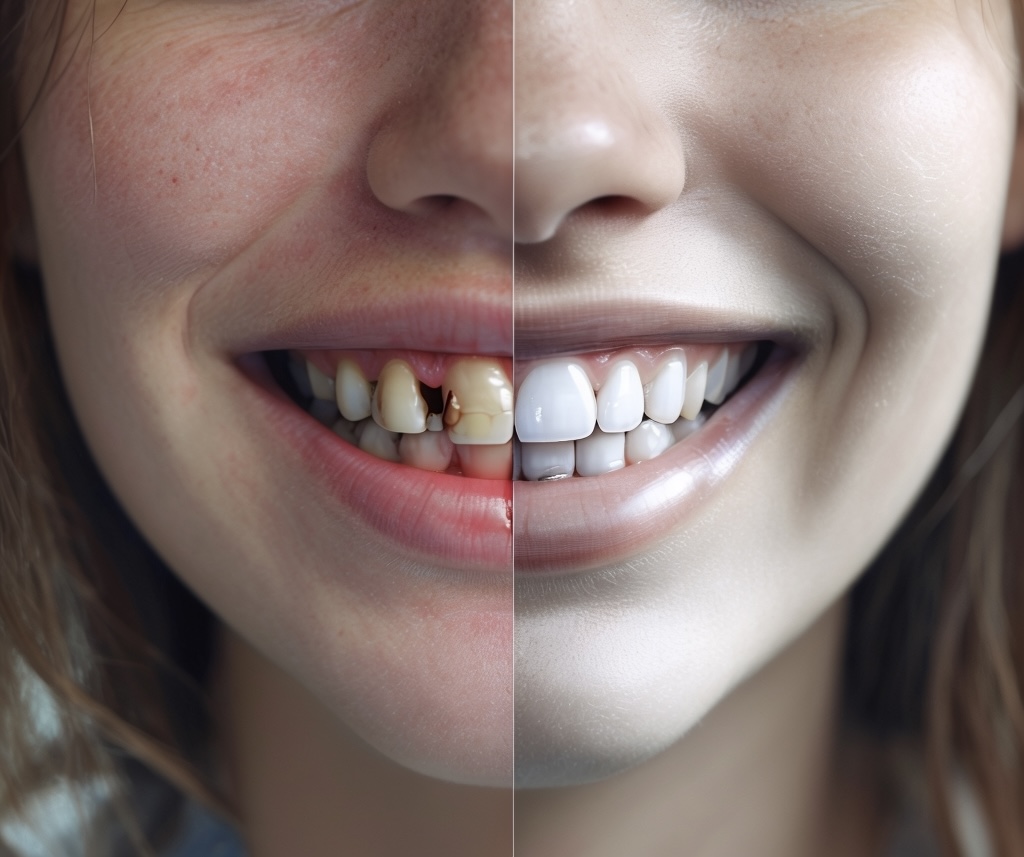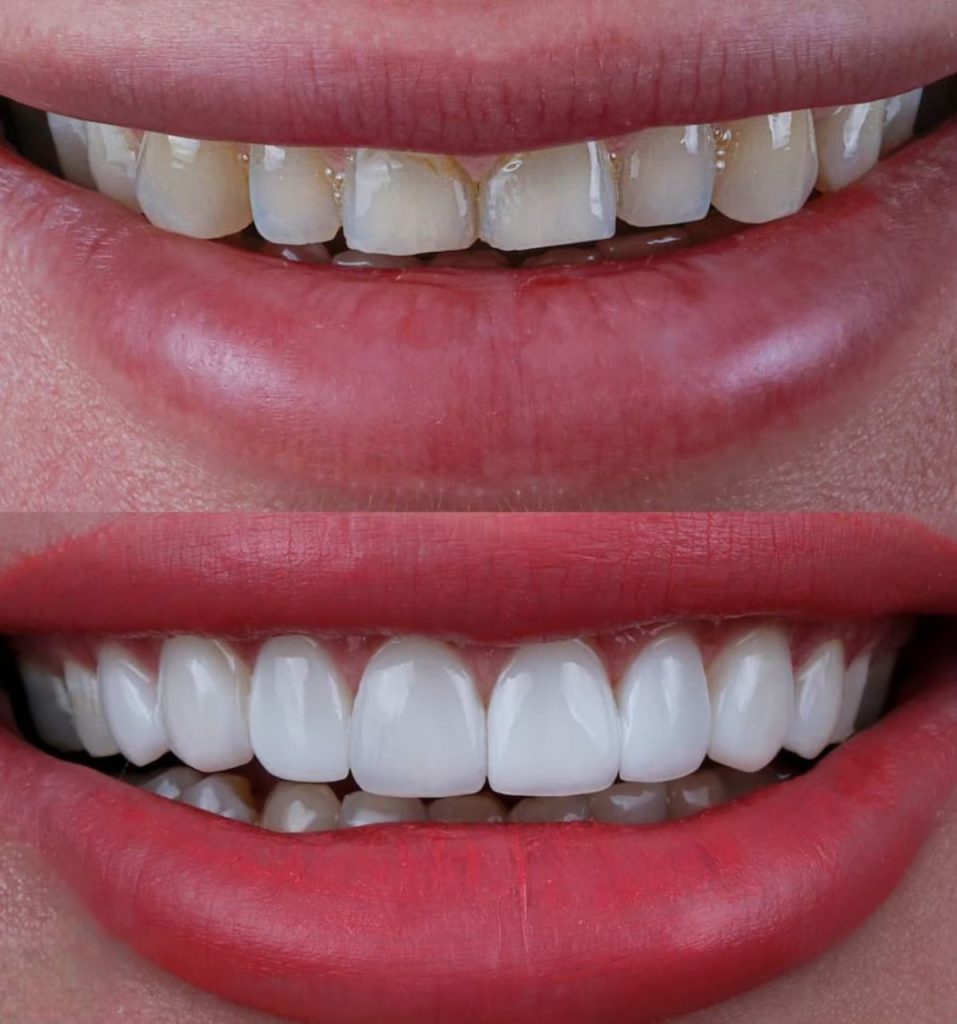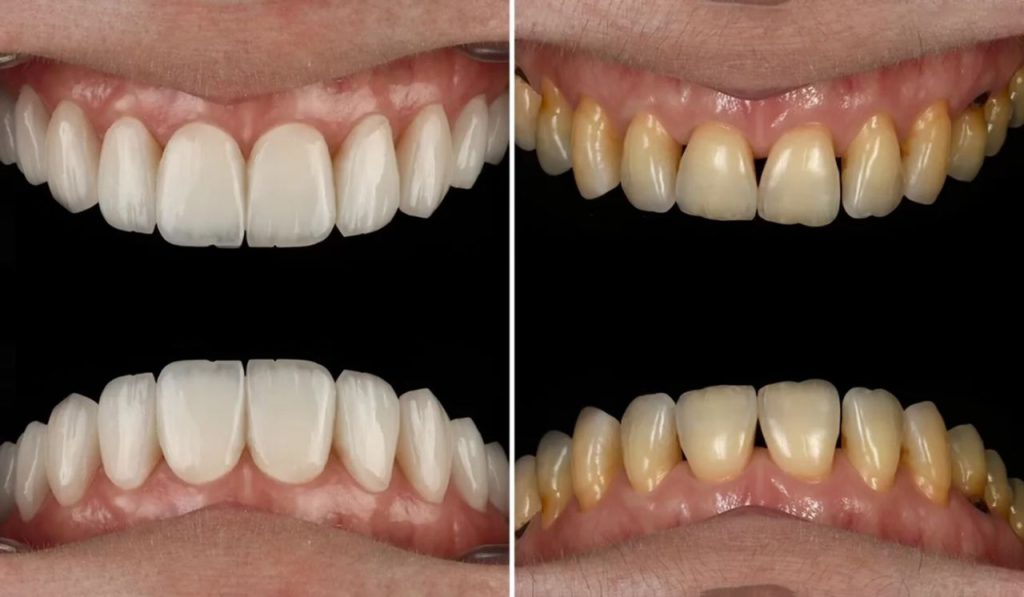Dental veneers have become increasingly popular for enhancing the appearance of teeth. They offer a solution for various dental imperfections such as discoloration, chips, gaps, and minor misalignments. Two primary types of veneers are composite and porcelain. Each type has its own set of advantages and disadvantages, and understanding these differences can help you make an informed decision about the best option for your smile. For more on modern dentistry, visit the Complete Guide to Modern Dentistry Services, Treatments, and Innovations.
Composite Veneers:

Composite veneers are made from a tooth-colored resin that is applied directly to the tooth’s surface and shaped by the dentist. This type of veneer is often chosen for its cost-effectiveness and quick application. To understand more about innovative techniques in dentistry, check out The Future of Dentistry.
Advantages:
- Cost-Effective: Composite veneers are generally less expensive than porcelain veneers, making them an accessible option for many patients. This affordability can be particularly appealing for those who need multiple veneers.
- Quick Application: The procedure for composite veneers can usually be completed in one visit. The dentist applies the composite material directly to the teeth, shapes it, and hardens it using a special light. This allows for immediate results and is ideal for those who want a quick smile makeover.
- Minimal Tooth Preparation: Composite veneers require less removal of the natural tooth structure compared to porcelain veneers. This means that more of the original tooth is preserved, which can be beneficial for the overall health and strength of the tooth.
- Repairable: If a composite veneer is damaged or chipped, it can often be repaired without replacing the entire veneer. The dentist can simply add more composite material to the affected area and reshape it. For information on dental treatments, refer to A Complete Guide to Modern Dentistry.
Disadvantages:
- Shorter Lifespan: Composite veneers typically last 5 to 7 years, which is shorter compared to porcelain veneers. According to the American Dental Association, they may need to be replaced more frequently, which can add to the overall cost over time.
- Staining: Composite veneers are more prone to staining from food, drinks, and smoking compared to porcelain veneers. Regular polishing and proper oral hygiene are necessary to maintain their appearance. For preventive strategies, visit How to Prevent Tooth Decay.
- Less Natural Appearance: Although composite veneers improve the look of teeth, they may not match the translucency and natural look of porcelain veneers. They can appear slightly more opaque and less lifelike.
- Wear and Tear: Composite veneers are less durable and more susceptible to chipping and wear over time. They may not be the best option for individuals who grind their teeth or have habits that could damage the veneers. For effective strategies to relieve tooth pain, visit Effective Strategies to Relieve Tooth Pain.
Porcelain Veneers:

Porcelain veneers are thin shells made of ceramic material that are bonded to the front of the teeth. They are known for their natural appearance and durability, making them a popular choice for cosmetic dentistry. According to a study published on PubMed, porcelain veneers can significantly improve dental aesthetics. For a complete guide to dental implants and post-care, refer to Comprehensive Guide to Dental Implants and Post-Care.
Advantages:
- Natural Aesthetic: Porcelain veneers provide a more natural and lifelike appearance due to their translucency and ability to mimic the light-reflecting properties of natural teeth. They are custom-made to match the color, shape, and size of your natural teeth, resulting in a seamless and beautiful smile.
- Durability: Porcelain veneers can last 10 to 15 years with proper care, offering a long-term solution for dental aesthetics. Their durability makes them a worthwhile investment for those looking for a permanent solution.
- Stain Resistance: Porcelain veneers are resistant to staining from food, drinks, and smoking. This means they maintain their pristine appearance over time, requiring less maintenance compared to composite veneers.
- Strength: Porcelain veneers are more durable and resistant to chipping and cracking compared to composite veneers. They can withstand the normal wear and tear of daily use, making them a reliable choice for enhancing dental appearance.
- Custom Fit: Each porcelain veneer is custom-made to fit the patient’s teeth, ensuring a precise and comfortable fit. This customization ensures that the veneers blend seamlessly with your natural teeth. To learn more about orthodontic treatments, visit our comprehensive guide.
Disadvantages:
- Cost: Porcelain veneers are more expensive than composite veneers, which might be a limiting factor for some patients. The higher cost is due to the materials used and the complexity of the manufacturing process.
- Multiple Visits Required: The process of getting porcelain veneers typically requires two or more dental visits. The first visit involves the initial consultation and preparation of the teeth, while the second visit is for the final placement of the veneers. This means it takes more time to complete the procedure compared to composite veneers.
- Tooth Preparation: Porcelain veneers require more removal of the natural tooth structure compared to composite veneers. The dentist needs to remove a thin layer of enamel from the surface of the teeth to ensure a proper fit. This can be a drawback for those looking to preserve their original teeth as much as possible.
- Irreversible Procedure: Once the tooth enamel is removed for the placement of porcelain veneers, the process is irreversible. This means that if you decide to remove the veneers in the future, your teeth will always require some type of restoration. For innovative dental techniques, refer to The Future of Dentistry.
Detailed Comparison:
| Criterion | Composite Veneers | Porcelain Veneers |
|---|---|---|
| Material | Tooth-colored resin | Ceramic (porcelain) |
| Lifespan | 5 to 7 years | 10 to 15 years |
| Cost | Less expensive | More expensive |
| Application Time | Usually completed in one visit | Requires two or more visits |
| Tooth Preparation | Minimal removal of tooth structure | More removal of tooth structure |
| Appearance | Less natural | Highly natural and lifelike |
| Stain Resistance | Prone to staining | Resistant to staining |
| Repairability | Can be repaired | Generally not repairable, must be replaced |
| Durability | Less durable | More durable |
| Customization | Standard shaping and fitting | Custom-made to fit each patient |
| Reversibility | Reversible procedure | Irreversible procedure |
Clinical Applications:
Composite and porcelain veneers are used to address a variety of dental issues. Here are some common applications for each type:
Composite Veneers:
- Chipped or Worn Teeth: Composite veneers can quickly and effectively restore the appearance of chipped or worn teeth, providing a seamless and natural look.
- Discolored Teeth: They can cover stains and discolorations that cannot be addressed by traditional teeth whitening methods, resulting in a brighter smile.
- Minor Misalignments: Composite veneers can correct minor misalignments and improve the overall symmetry of the smile, making them an excellent choice for minor orthodontic corrections.
- Gaps Between Teeth: Composite veneers can close small gaps between teeth, creating a more uniform and aesthetically pleasing appearance.
Porcelain Veneers:

- Severely Discolored Teeth: Porcelain veneers are ideal for covering severe discolorations and stains that do not respond to other treatments. They provide a long-lasting solution for achieving a whiter smile.
- Gaps Between Teeth: They can be used to close small gaps between teeth, providing a more uniform appearance.
- Misshapen Teeth: Porcelain veneers can reshape and improve the appearance of misshapen or irregularly sized teeth, resulting in a harmonious smile.
- Extensive Wear: They are suitable for patients with extensive wear and tear on their teeth, providing a durable and long-lasting solution.
Maintenance and Care:
Proper maintenance and care are essential to prolong the lifespan and appearance of both composite and porcelain veneers. Here are some tips for maintaining each type:
- Regular Brushing and Flossing: Maintain good oral hygiene by brushing and flossing regularly to prevent decay and gum disease.
- Avoid Staining Foods and Drinks: Limit the consumption of staining foods and drinks such as coffee, tea, and red wine to keep the veneers looking their best.
- Regular Dental Check-ups: Visit your dentist regularly for check-ups and professional cleanings to ensure the veneers remain in good condition.
- Polishing: Have your composite veneers polished annually to maintain their appearance and prevent staining.
Porcelain Veneers:
- Regular Brushing and Flossing: Maintain good oral hygiene by brushing and flossing regularly to prevent decay and gum disease.
- Avoid Hard Foods: Avoid biting into hard foods or objects that could chip or crack the veneers, such as ice or hard candies.
- Regular Dental Check-ups: Visit your dentist regularly for check-ups and professional cleanings to ensure the veneers remain in good condition.
- Non-Abrasive Toothpaste: Use a non-abrasive toothpaste to avoid scratching the surface of the veneers and maintain their smooth finish.
Frequently Asked Questions (FAQs):
How long do composite veneers last?
Composite veneers typically last 5 to 7 years with proper care. Regular dental check-ups and good oral hygiene can help extend their lifespan.
How long do porcelain veneers last?
Porcelain veneers can last 10 to 15 years with proper care, making them a more durable option compared to composite veneers.
Are porcelain veneers worth the extra cost?
Porcelain veneers are more expensive than composite veneers, but they offer a more natural appearance, longer lifespan, and greater stain resistance. They may be worth the investment for those seeking a long-term solution.
Can veneers fix crooked teeth?
Veneers can correct minor misalignments and improve the overall appearance of slightly crooked teeth. For more severe misalignments, orthodontic treatment may be necessary.
Do veneers require special care?
Both composite and porcelain veneers require regular brushing, flossing, and dental check-ups. Avoiding hard foods and using non-abrasive toothpaste can also help maintain their appearance and longevity.
Conclusion:
Choosing between composite and porcelain veneers depends on various factors, including budget, desired appearance, and the specific needs of your teeth. While composite veneers offer a cost-effective and quicker solution, porcelain veneers provide a more natural look and longer-lasting results. It’s essential to consult with your dentist to determine which option is best suited for you.
